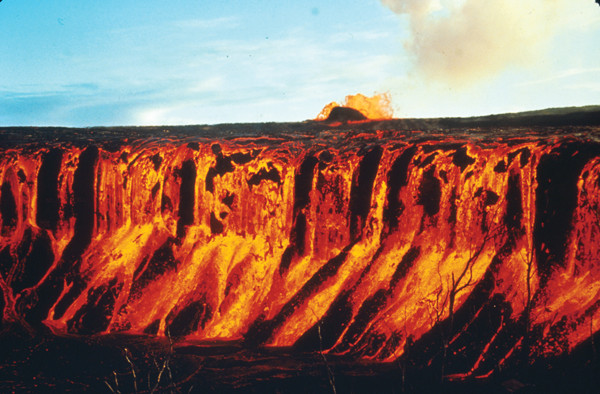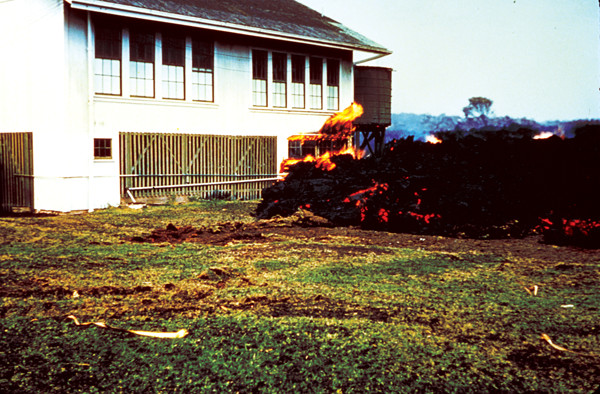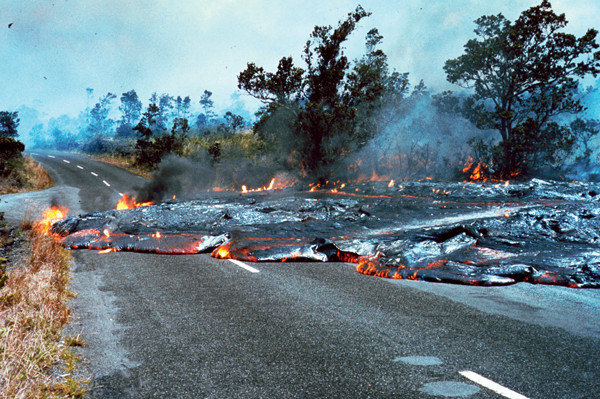
by Harvey Leifert Wednesday, May 16, 2012

Kilauea can produce flowing lava fed by colorful fountains — seen here in December 1969. Don Swanson, U.S. Geological Survey Photographic Library

Even Kilauea's more gentle flows can be quite destructive, such as when lava took out this school in Kapoho in January 1960. U.S. Geological Survey Photographic Library

Lava flows across Chain of Craters Road in Hawaii Volcanoes National Park on May 5, 1973. R.L. Christiansen, U.S. Geological Survey Photographic Library
“Namakeha and some other chiefs in the train of Kamehameha, went with soldiers to Ka’u [on the southern coast of the Big Island of Hawaii], to exterminate Keōua. But Keōua was at Hilo [in the east]. He heard of the invasion of the enemy and hastened to the scene of the action. His path led by the great volcanoe of Kilauea. There they encamped. In the night a terrific eruption took place, throwing out flame, cinders and even heavy stones to a great distance, and accompanied from above with intense lightning and heavy thunder … [O]n the second night and on the third night also there were similar eruptions. On the third day they ventured to proceed on their way, but had not advanced far, before a more terrible and destructive eruption than any before, took place …
“The army of Keōua set out on their way, in three different companies. The company in advance had not proceeded far, before the ground began to shake and rock beneath their feet, and it became quite impossible to stand. Soon a dense cloud of darkness was seen to rise out of the crater, and almost at the same instant the electrical effect upon the air was so great, that the thunder began to roar in the heavens and the lightning to flash … Some few persons of the forward company were burned to death by the sand and cinders and others were seriously injured. All experienced a suffocating sensation upon the lungs and hastened on with all possible speed.
“The rear body, which was closest to the volcanoe at the time of the eruption, seemed to suffer the least injury … But what was their surprise and consternation, when on coming up with their comrades of the centre party, they discovered them all to have become corpses … The whole party, including women and children, not one of them survived to relate the catastrophe that had befallen their comrades.”
Sheldon Dibble, “History of the Sandwich Islands” (1843)
In November 1790, Kilauea, the most accessible of the five volcanoes that comprise Hawaii’s Big Island, erupted violently. Contemporary accounts vary widely, but the eruption claimed between 80 and 5,405 lives, more than any other eruption in the United States. The main victims were warriors engaged in a struggle between their leader, Keōua, and Kamehameha, who would eventually become king, for control of the island. The terrifying event was described by Sheldon Dibble, a Christian missionary, in his 1843 book, “History of the Sandwich Islands” (see above).
The explosive history of Kilauea is not well known. Today, it’s renowned for lobes of slow-moving, calm lava, which ooze out of cracks in the flanks of the volcano, pour downslope and eventually flow into the sea, where the lava cools and gradually enlarges the island. About 206 hectares of new land have been created since the current eruption began in 1983.
Kilauea attracts some 5,000 visitors daily. From various vantage points, they watch dramatic lava flows, in awe of a spectacle that is unique in the world for its consistency, which prompted UNESCO to declare it a World Heritage Site.
Most visitors assume that as long as they stay back from flowing molten lava and follow the National Park Service’s rules, Kilauea poses no danger. That is true in the short term but not the long term.
As the Hawaiians learned in 1790, Kilauea is capable of explosive eruptions and has already killed far more people than any other volcano in what is now the United States. Scientists know there are numerous lava fountains and spattering eruptions at Kilauea, such as on Jan. 18, 2011, from Kilauea’s lava lake at Halemaumau, but these eruptions are mild compared with the violent eruptions now under study.
Now, researchers have learned that violent eruptions at Kilauea are not always isolated events. Over the past 2,500 years, violent eruptive periods lasting centuries have alternated with periods of quiet flows, such as we have seen for the past 29 years. Once an explosive period has begun, conditions on the Big Island will be very different from those on which the past hazard assessment was based. Volcanologists are currently at work on revising the hazard assessment before the next explosive period begins.
Scientists at the U.S. Geological Survey’s (USGS) Hawaiian Volcano Observatory (HVO), perched on the rim of Kilauea’s caldera, recently assembled a rough chronology of Kilauea’s explosive and quiet periods using carbon-14 dating techniques. Their investigation, aided by colleagues at the Smithsonian Institution and the University of Hawaii, accords with oral accounts handed down by native Hawaiians and published by Christian missionaries.
The danger that Kilauea poses is significant, said Don Swanson of HVO at the annual meeting of the American Geophysical Union in San Francisco, Calif., last December, where he reported on research he led. Swanson’s investigation revealed that Kilauea’s most explosive eruptions are not isolated incidents, but part of long-term trends, he reported.
The new research involved radiocarbon dating of charcoal formed over the past 2,500 years. Some of the charcoal formed when lava flowed through vegetation and burned it; more formed when ash fell on vegetation and burned it. To obtain their samples for testing, Swanson and his colleagues scraped and dug at the base of lava flows, where charcoal is best preserved. They also found charcoal embedded in ash deposits that they encountered in excavations. All told, the team obtained 200 specific ages, half from lava samples and half from ash from several tens of eruptions.
The carbon dating, carried out at Lawrence Livermore National Laboratory in California and at the University of Arizona, revealed that Kilauea alternates between periods of quiet lava flows and explosive eruptions that last centuries. The most recent explosive period lasted from about A.D. 1500 to 1800, during which Kilauea violently erupted at least 20 times — with the most deadly being the 1790 eruption.
Evidence suggests that most of the fatalities in the 1790 eruption were caused by a pyroclastic density current, or PDC, a mixture of hot gas and volcanic ash moving at hurricane speed that engulfed and killed the warriors and their accompanying families by heat and asphyxiation. (PDC is a general term that encompasses several types of events. HVO scientists characterize those that have occurred at Kilauea as surges. Another, perhaps better-known term, pyroclastic flow, describes a different type of PDC.) Scientists at HVO have located, near the observatory, traces of PDC deposits from the 1790 eruption, as well as footprints made in muddy volcanic ash just prior to the arrival of the PDC that may record the last steps of some of Keōua’s warriors.
The 1790 eruption was not, however, Kilauea’s most powerful. Almost 1,000 years earlier, in about A.D. 800, an explosive eruption sent small stones up to 18 kilometers away, and deposited a 4.4-kilogram rock five kilometers from the vent. That eruption was part of an explosive period lasting from about 200 B.C. to A.D. 1000. The signs that had previously been attributed to one eruption in 200 B.C. are now known to have resulted from many explosive eruptions throughout that 1,200-year period. Before 200 B.C. and in between the explosive periods of 200 B.C. to A.D. 1000 and 1500 to 1800, Kilauea was in a “quieter” lava flow period, as it is today. That is not to say that quieter periods cannot also be destructive: Since 1983, when the current, almost nonstop, lava flows began, 213 structures have been destroyed and 13.5 kilometers of highway covered and rendered impassable. All told, over the 2,500-year period covered by the new research, Kilauea was in an explosive state 60 percent of the time.
During the explosive periods, Swanson says, each individual explosive eruption may have lasted hours to weeks, with quiet periods between lasting weeks to a few decades. Likewise, during periods of effusive flow, short-lived fountaining eruptions like the one in March 2011 can occur.
But what causes Kilauea’s transition from one state to the other? The answer is related to the condition of the volcano’s caldera, the crater at its summit, Swanson says. The depth of the caldera and its relationship to the depth of the water table is key to understanding Kilauea’s eruption cycles.
The water table today is about 615 meters below the rim of the caldera, whereas the floor of the caldera is at a depth of about 120 meters. “We think this is a good measure of the minimum depth that the caldera floor must have reached to initiate explosive activity,” Swanson says. “When the caldera is deep enough to intersect the water table, groundwater can become involved in the eruptions, which are predominantly explosive owing to the steam produced by heating of the water.”
Over time, Swanson says, “the long periods of explosive activity imply that the caldera remains that deep for equally long periods, or that it begins to fill and then recollapses down to a depth of 600 meters or greater below the caldera’s rim. Once the caldera is able to fill with lava to a shallower depth and doesn’t collapse, the explosive period ends and the cycle of lava flows begins.”
In addition, HVO geologists conclude that when the supply of magma below the floor of the caldera is high, as it currently is, eruptions occur as lava flows. “If, however, the magma reservoir drops significantly and therefore no longer supports the summit, the caldera walls can collapse,” Swanson says. “Explosive eruptions can then occur, spewing rock from the collapsed walls high into the air, along with ash and lava. This happens occasionally during periods of lava flows, but for Kilauea to transition into a continuing explosive period, the magma supply to the shallow reservoir must remain low.”
The reason why the magma supply to the reservoir might decrease is not known, Swanson says, but there are several possible explanations. Basically, either less magma is rising from the hot spot below the ocean floor, or it is being diverted prior to reaching the reservoir. In the latter case, the magma might flow directly to the ocean floor or, less likely, he says, it may enter the neighboring Mauna Loa system. “It is probably the variation of magma supply to Kilauea that is the most fundamental aspect of the cycles,” he says. In short, “low supply leads to long periods dominated by explosive activity, and high supply to long periods of lava flows.”
Geologist Frank Trusdell, who specializes in Mauna Loa at HVO, has found an inverse relationship between Kilauea and its 4,170-meter-high neighbor: During some periods in the past, such as between 1823 and the early 1900s, when Kilauea was quiet, Mauna Loa was erupting copious lava flows, and at other times, when Kilauea poured out large amounts of lava, Mauna Loa slowed to a trickle. This suggests a physical connection between the two magma systems deep underground, which both Trusdell and Swanson say is still speculative at this point. For one, Swanson says, the magmas of the two volcanoes are isotopically different and can therefore be distinguished.
Trusdell has developed a hypothesis concerning the Mauna Loa-Kilauea relationship based on historical accounts and his recent research into prehistoric eruptions. He notes, for example, that in the period between 1823 and the early 1900s, Kilauea’s crater contained a lava lake: “You walk up to the edge of this crater, and there’s a boiling cauldron of lava in front of you,” he says. At the same time, Mauna Loa was erupting copious amounts of lava.
“My new hypothesis,” Trusdell says, “is that if you have a standing lava lake only in the summit of [Kilauea], and the lava is not spilling over and blanketing the near-surface flanks, you actually still have modest levels of magma supply into the volcano. And in turn, what that means is that Kilauea’s south flank is actually quite stable.” The south flank is Kilauea’s downhill side, away from Mauna Loa.
When Kilauea erupts explosively, however, its south flank moves, which can now be determined with GPS measurements. When the south flank is not buttressing Kilauea’s summit, Mauna Loa pushes against it. “You end up creating more space in Mauna Loa,” Trusdell says, “which reduces the pressure of the magma within” and therefore the propensity to erupt.
“It’s a tectonic phenomenon that’s driving this inverse correlation,” he says. Once the magma leaves the hot spot underlying the island, “we are fairly confident that [these two volcanoes] have independent plumbing systems.”
Currently, Mauna Loa has been showing very modest rates of inflation, Trusdell says, “and yet, there is no seismicity. In order for us to forecast an oncoming event from Mauna Loa, we would expect there to be increased seismicity. Therefore, Mauna Loa is not going to erupt imminently,” he concludes, adding, “if things change, then we will change the forecast.”
In general, “it seems to take a caldera collapse to trigger the explosions, not vice versa,” Swanson says. Furthermore, he says, judging from recent caldera collapses at basaltic volcanoes, including Fernandina in the Galapagos Islands in the late 1960s and Miyakejima in Japan in 2000, the collapses appear to take days to weeks. “In this sense, [at Kilauea] the transition would be gradual; we would certainly know it was happening, and the authorities could react accordingly,” he says. “I would very much doubt that the next explosive period would start with a sudden explosion; we see no evidence of that anywhere.”
So, should the residents of communities close to Kilauea and the 5,000 daily visitors to Hawaii Volcanoes National Park, in which Kilauea lies, be worried? After all, within the radius of the 1790 pyroclastic density current lie the rapidly growing communities of Volcano Village and Golf Course Estates, home to 3,000 people. Although acknowledging that an explosive eruption could occur at any time without warning, Swanson says that he is confident that the odds of this happening are low. He estimates that there is a one in 438,000 chance of a devastating eruption, like that of A.D. 800, occurring on any given day. “But,” he adds, “the probability is not zero.”
HVO constantly monitors the depth of the caldera, along with many other parameters. Should the bottom of the caldera begin sinking from its current depth of about 120 meters toward the danger level of 600 meters, scientists would alert public safety authorities to the possibility of explosive eruptions triggered by steam generation as magma heats the groundwater. The only safe course would be evacuation.
If the sinking is not transitory, but heralds the beginning of a new explosive era, those evacuations may become permanent. Homes and businesses may have to be abandoned. Highway 11, the main cross-island artery between Hilo and the western coast of Hawaii, would likely be closed, either as a precaution or because of accumulations of ash on its roadway. An explosive Kilauea would not only seriously affect the life and economy of the Big Island, but it would also affect air traffic. Many trans-Pacific routes pass over or near the Hawaiian Islands and would be susceptible to rising columns of ash.
These scenarios may one day unfold, but, in the meantime, HVO scientists say they do not want to be alarmist. Although they cannot predict when the current period of mild, effusive activity will end, “there is no reason for anyone to change plans,” Swanson says. “In fact, it is a good time to visit Kilauea, because the activity is mild and nonthreatening.” At least most of the time.
© 2008-2021. All rights reserved. Any copying, redistribution or retransmission of any of the contents of this service without the expressed written permission of the American Geosciences Institute is expressly prohibited. Click here for all copyright requests.